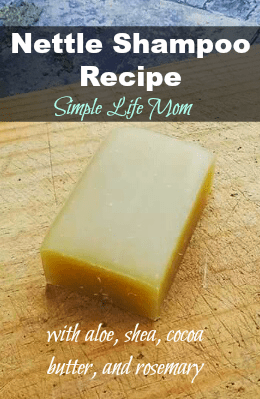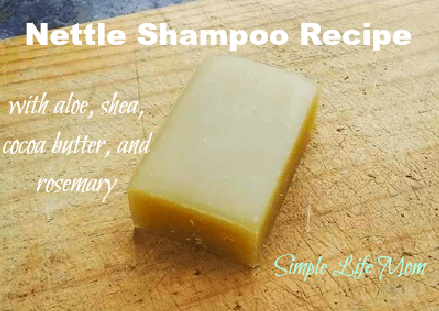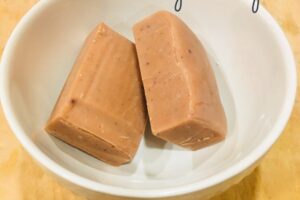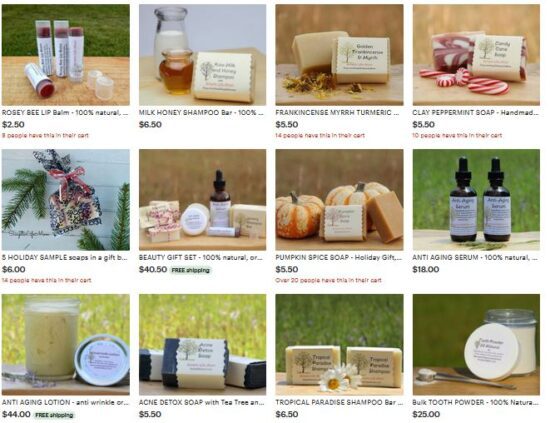If you’ve never learned about stinging nettle, then you may just be familiar with it because you’ve walked through the woods and brushed your bare legs against it, causing a burning sensation. After all, it’s called stinging nettle for a reason. But nettle has been used for medicinal purposes for centuries, which is one reason that I created this nettle shampoo recipe with aloe vera for you to enjoy.

Why Use Nettle
Nettle has been used for centuries, dating back to records in Ancient Greece.
Nettle is used today for joint pain and arthritis by drinking nettle tea or heating in oil, making a tincture to create a topical oil. I also personally know people who sting the joint to stimulate the nerves, blood flow, and healing and their joint pain is actually healed in this way.
Nettle tea also helps fight allergies. It is a natural antihistamine by containing anti-inflammatory properties and histamine! A great thing to know for those of us who deal with seasonal allergies.
What about skin and hair?
Nettle is wonderful for treating dry skin and eczema. It regulates oil production, reduced inflammation, and helps skin to heal faster.
Hair, under these conditions, regulates so that greasiness is no longer an issue and hair can grow faster.
How to Harvest Nettle
Nettle can be found in most wooded areas of America, especially in the north east. It is a leafy plant that can be 2-4 feet in height and blooms all summer.
It’s a fuzzy plant with most of the small spiky bits on the underside of the leaf and stem. It looks pretty harmless, but is extremely irritating to the skin when touched.
The answer: use gloves! Cut the plant off near the base, leaving part of the plant so that you can harvest more later.
It will still sting you until it is boiled. Rest assured that once you make a tea of it, it will no longer irritate the skin.
Shampoo Ingredients
This nettle shampoo recipe has a lot of wonderful ingredients that come together to make an incredible shampoo bar for all hair types, but especially for those with oily or dry hair.
Coconut Oil – Coconut oil adds hardness, bubbles, cleansing and conditioning to the shampoo. Find some here.
Olive Oil – Olive oil is gentle on the hair and is a wonderful addition to the saponification process. Find some here.
Castor Oil – Castor oil is my number one lathering ingredient. Though many ingredients add bubbles, castor oil makes big and small bubbles and makes a great addition to shampoos. Find some here.
Shea Butter – Shea butter adds a creamy texture to shampoo. Find some here.
Cocoa Butter – Cocoa butter adds hardness, vitamins, a stable lather, and conditioning. Find some here.
Sweet Almond Oil – Sweet almond oil adds vitamin E, A, and give a great lather to a shampoo bar. Find some here.
Nettle Tea – Nettle helps stimulate hair growth and regulate oil production, as well as calm itchy, irritated scalps. If you don’t know where to forage for nettle, you can make a tea using this.
Aloe Vera Liquid – Aloe is also known for calming skin and nourishing hair, making it a great addition to this recipe. Find some here.

Nettle Shampoo Recipe
This nettle shampoo recipe is a cold process recipe. If you’re not familiar with making cold process soap, see my instructions: 7 Easy Steps to Homemade Soap and my books The Natural Soap Making Book for Beginners or my Ebook Natural Soap Making How-To Recipe Book
Makes 3.5 lbs
Superfat 10%
Ingredients:
- 13 oz Olive Oil
- 10 oz Coconut Oil
- 7 oz Castor Oil
- 3 oz Sweet Almond Oil
- 3 oz Cocoa Butter
- 1 oz Shea Butter
- 8 oz Water
- 6 oz Aloe Vera Liquid
- 4.9 oz Lye
- 1 cup fresh Stinging Nettle or 2 Tablespoon dried nettle
- 1 oz Rosemary Essential Oil
Directions:
- Make nettle tea by boiling water and adding nettle and letting it steep for 10 minutes. Strain and discard leaves.
- Weigh oils and place in a large stainless steel pot. Melt oils and cool to 100 degrees Fahrenheit.
- Weigh nettle tea and add enough aloe to make 14 ounces. Take outside and, while wearing protective gloves, eye glasses, and mask, pour lye into aloe nettle tea and stir until dissolved. Allow to cool to 100 degrees Fahrenheit.
- Add lye water to oils and mix with a hand mixer until light trace.
- Add essential oils and blend.
- Pour into prepared mold and insulate for 24 hours before removing and allowing to cure for 4-6 weeks.







17 Comments
Leave your reply.